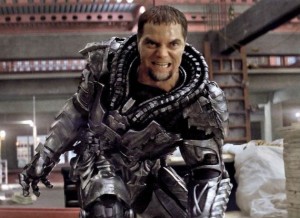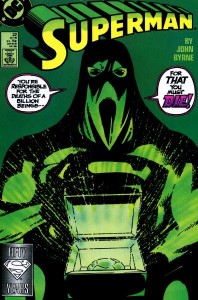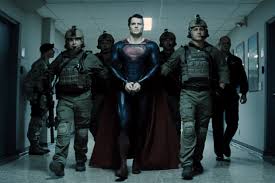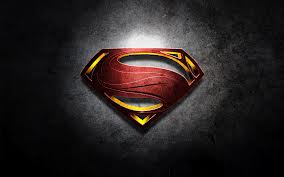The SFC’s Mike saw Man of Steel and offers these opening night reactions. (You can read Part 1 here.)
Zod Man Out
 Michael Shannon has some impressive moments as General Zod—he conveys anger at his banishment to the Phantom Zone without being haunted by the performance of Terence Stamp; makes remarkably good work of some “monologing” as he outlines his plan to resurrect Krypton at Earth’s expense; dialogues with dead Jor-El with a convincing amount of venom; and compellingly plays his painful acquisition of powers under Earth’s yellow sun—but he tells rather than shows the heart of Zod’s character, and that renders him far less menacing. Likewise, Superman tells us Zod is a monster, but we don’t see that fact enough for ourselves. What we hear is an intriguing take on the character—namely, “No matter how violent, every action I take is for the greater good of my people”—but Shannon doesn’t embody this motivation as fully as I would have liked. We also sense no real connection between Zod and his lieutenant, Faora (Antje Traue, in a thankless role—the script doesn’t even let her talk about her motivation; she is simply a lethal killer). I want a Zod who will have me so scared I’ll offer to kneel before him before he ever commands me to do so, and Shannon just isn’t it. (Kudos to the screenwriters, incidentally, for resisting what must have been the strong temptation to work that command into Zod’s dialogue at some point. It would have been deadly. Star Trek Into Darkness, take note!)
Michael Shannon has some impressive moments as General Zod—he conveys anger at his banishment to the Phantom Zone without being haunted by the performance of Terence Stamp; makes remarkably good work of some “monologing” as he outlines his plan to resurrect Krypton at Earth’s expense; dialogues with dead Jor-El with a convincing amount of venom; and compellingly plays his painful acquisition of powers under Earth’s yellow sun—but he tells rather than shows the heart of Zod’s character, and that renders him far less menacing. Likewise, Superman tells us Zod is a monster, but we don’t see that fact enough for ourselves. What we hear is an intriguing take on the character—namely, “No matter how violent, every action I take is for the greater good of my people”—but Shannon doesn’t embody this motivation as fully as I would have liked. We also sense no real connection between Zod and his lieutenant, Faora (Antje Traue, in a thankless role—the script doesn’t even let her talk about her motivation; she is simply a lethal killer). I want a Zod who will have me so scared I’ll offer to kneel before him before he ever commands me to do so, and Shannon just isn’t it. (Kudos to the screenwriters, incidentally, for resisting what must have been the strong temptation to work that command into Zod’s dialogue at some point. It would have been deadly. Star Trek Into Darkness, take note!)
On the other hand, the climactic mano-a-mano between Superman and Zod is everything Superman fans—for that matter, fans of superhero film action in general—lamented was missing from Superman Returns. We are treated (and it is a treat to behold) to a high-octane, meta-mortal knock-down drag-out with good guy and bad guy packing impossibly powerful punches and inflicting some crazy dramatic collateral damage (but only, as befits a Superman story, on property; Big Blue makes a point of telling some bystanders to seek shelter before the really rough stuff gets going—quintessential Superman!). I was reminded not only of Superman II, of course (especially in the way the product placement signs got smashed—neon Coke sign and Marlboro truck, anyone?—and, in a great Easter egg, a couple of Lexcorp trucks), but also of such classic fights from the Byrne-and-beyond era as the epic conflicts in Panic in the Sky and, without question, the battle with Doomsday. (I wonder if the sequel will dare take on the Death and Return? A live-action treatment of Superman’s most famous modern story would no doubt be something to see.)
 And Great Rao! (Pardon my Kryptonese.) Superman kills Zod! We’re not messing around with super-cellophane chest shields, boys and girls; Superman snaps Zod’s neck. Wow. I expect some long-time Superman fans won’t like the way the duel ends, but (a) Superman did it in the moment to save innocent lives, entirely consistent with his character; (b) Superman has killed in the post-Crisis era—he’s killed General Zod, in fact (Superman #22, as seen here—story and art by Byrne); and (c) Superman grieves what he has done (in a far more effective scream than some other recent movies have showcased—again, Into Darkness, learn something here). I would have appreciated a few beats more as Superman processed what he had done; however, this adventure is Superman’s first big foray into action in the Man of Steel mythos, and it might serve to move him toward, rather than draw him away from, the no-killing ethic we traditionally associate with Superman.
And Great Rao! (Pardon my Kryptonese.) Superman kills Zod! We’re not messing around with super-cellophane chest shields, boys and girls; Superman snaps Zod’s neck. Wow. I expect some long-time Superman fans won’t like the way the duel ends, but (a) Superman did it in the moment to save innocent lives, entirely consistent with his character; (b) Superman has killed in the post-Crisis era—he’s killed General Zod, in fact (Superman #22, as seen here—story and art by Byrne); and (c) Superman grieves what he has done (in a far more effective scream than some other recent movies have showcased—again, Into Darkness, learn something here). I would have appreciated a few beats more as Superman processed what he had done; however, this adventure is Superman’s first big foray into action in the Man of Steel mythos, and it might serve to move him toward, rather than draw him away from, the no-killing ethic we traditionally associate with Superman.
Generally, I don’t think killing the villain is the best ending for any superhero tale, let alone a Superman story. I think, with some more creative thought, some other solution might have been scripted in this instance. But do I think Superman’s action, under the circumstances given, irreparably damages his character? Again, given that Man of Steel shows us a Superman who’s new on the job, no. I hope it can be grist for the story-telling mill in what’s yet to come.
A Super-Messiah Complex?
As with Superman: The Movie and Superman Returns, there is explicit spiritual content in Man of Steel. Jor-El says, as he prepares to launch his infant son into space, that Kal-El will be “as a god” to human beings; and, in his posthumous form, he sends Superman into the world in a way that may remind Christian viewers of the Father sending the Son to embark on the mission of salvation (although Man of Steel avoids belaboring those relational terms, as they were belabored in Superman II: The Richard Donner Cut and Superman Returns). Superman’s salvific task in this film is to be the great moral exemplar—to be a living symbol, decrees Jor-El, of the potential for good within all people. It’s not exactly John 3.16; but since Superman is a make-believe character and, when all is said and done, not Jesus Christ (spoiler alert), that’s all right by me. We Christians can still affirm that, like Superman, we have a Father who has “prepared” good works “beforehand to be our way of life” (Ephesians 2.10); and while Christian living is much more than good works, it certainly can’t be less. As the apostle James teaches, religion “that is pure and undefiled before God, the Father,” involves “being… doers [of God’s word] who act—they will be blessed in their doing” (1.27, 25).
 I also noted with pleasure the scene in which Clark seeks out his pastor, Father Leone (Coburn Goss) for spiritual counsel before he hands himself over to Zod. Whoever conceived of this scene clearly understands pastoral ministry in the smaller membership church, since Father Leone is mopping the sanctuary’s floors himself when we see him! More importantly, however, the scene makes another (admittedly none too subtle) connection between Clark and Christ: featured quite prominently in the background is a stained glass window depicting Jesus praying in the Garden of Gethsemane before his arrest. Just as Jesus willingly gave himself over to his enemies in order to accomplish the plan of salvation, Superman allows himself to be handed over to the United States Army (who begin but do not finish the film as his enemies—the movie doesn’t use the familiar phrase but nevertheless firmly adheres to the tradition of Superman as a champion of “the American way”) in the hope of saving the planet from Zod. As Jesus could have called upon “more than twelve legions of angels” to fight for him but chose not to (Matthew 26.53), Superman could flex those bulging biceps of his but allows himself to be handcuffed. The difference between the two, of course, is that—as he tells Lois—Superman is “playing along,” merely tolerating the military’s treatment of him in order to win their trust. Jesus, in contrast, really and truly “emptied himself, taking the form of a slave… [and] humbled himself and became obedient [to God] to the point of death—even death on a cross” (Philippians 2.8).
I also noted with pleasure the scene in which Clark seeks out his pastor, Father Leone (Coburn Goss) for spiritual counsel before he hands himself over to Zod. Whoever conceived of this scene clearly understands pastoral ministry in the smaller membership church, since Father Leone is mopping the sanctuary’s floors himself when we see him! More importantly, however, the scene makes another (admittedly none too subtle) connection between Clark and Christ: featured quite prominently in the background is a stained glass window depicting Jesus praying in the Garden of Gethsemane before his arrest. Just as Jesus willingly gave himself over to his enemies in order to accomplish the plan of salvation, Superman allows himself to be handed over to the United States Army (who begin but do not finish the film as his enemies—the movie doesn’t use the familiar phrase but nevertheless firmly adheres to the tradition of Superman as a champion of “the American way”) in the hope of saving the planet from Zod. As Jesus could have called upon “more than twelve legions of angels” to fight for him but chose not to (Matthew 26.53), Superman could flex those bulging biceps of his but allows himself to be handcuffed. The difference between the two, of course, is that—as he tells Lois—Superman is “playing along,” merely tolerating the military’s treatment of him in order to win their trust. Jesus, in contrast, really and truly “emptied himself, taking the form of a slave… [and] humbled himself and became obedient [to God] to the point of death—even death on a cross” (Philippians 2.8).
Warner Brothers has apparently been pushing Man of Steel as a homiletical tool for Christian preachers, but I’m more than ready for a major, live-action Superman movie that doesn’t play up the long-established similarities of the Last Son of Krypton to the Son of God. As Man of Steel itself argues, Superman isn’t here to save our souls, but to show us a better way to live, here and now, with each other. In Jor-El’s words, “They will race behind you, they will stumble, they will fall—but in time, they will join you in the sun.”
 Ultimately, beyond all of its affinities with post-Crisis Superman, that’s what Man of Steel gets right most of all. Superman is a character about hope, and this film is a hopeful one. It begins with Jor-El and Lara’s hope that their newborn will forge a way forward for Krypton. It ends with the hope that Kal-El will forge his way forward as a hero and friend to his adopted home world. It is a movie whose message is—as the best Superman stories in any era, from 1938 on have always proclaimed—that good is stronger than evil, that love is stronger than hate, and that light is stronger than darkness. For this reason, I want to see Man of Steel and the films that follow fly high.
Ultimately, beyond all of its affinities with post-Crisis Superman, that’s what Man of Steel gets right most of all. Superman is a character about hope, and this film is a hopeful one. It begins with Jor-El and Lara’s hope that their newborn will forge a way forward for Krypton. It ends with the hope that Kal-El will forge his way forward as a hero and friend to his adopted home world. It is a movie whose message is—as the best Superman stories in any era, from 1938 on have always proclaimed—that good is stronger than evil, that love is stronger than hate, and that light is stronger than darkness. For this reason, I want to see Man of Steel and the films that follow fly high.

One comment on “Does “Man of Steel” Get Superman Right? — Part 2 (With Spoilers)”